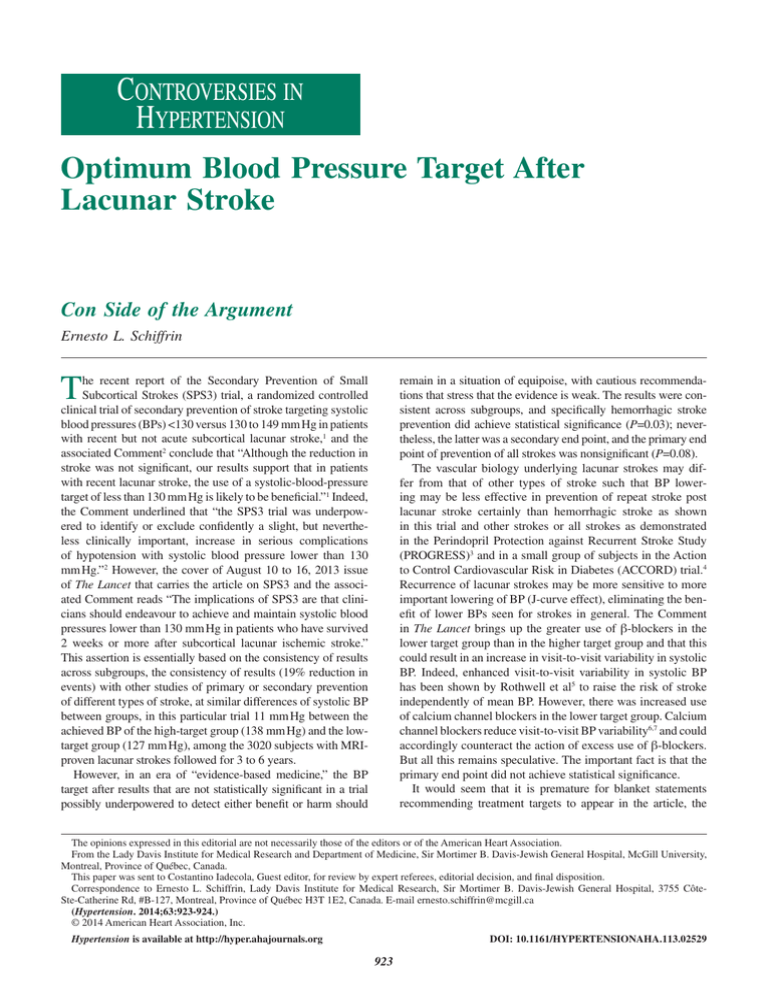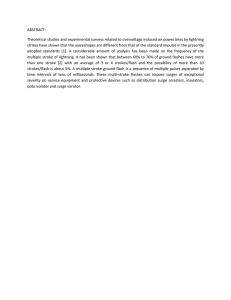Optimum Blood Pressure Target After Lacunar Stroke
advertisement

Controversies in Hypertension Optimum Blood Pressure Target After Lacunar Stroke Con Side of the Argument Ernesto L. Schiffrin T he recent report of the Secondary Prevention of Small Subcortical Strokes (SPS3) trial, a randomized controlled clinical trial of secondary prevention of stroke targeting systolic blood pressures (BPs) <130 versus 130 to 149 mm Hg in patients with recent but not acute subcortical lacunar stroke,1 and the associated Comment2 conclude that “Although the reduction in stroke was not significant, our results support that in patients with recent lacunar stroke, the use of a ­systolic-blood-pressure target of less than 130 mm Hg is likely to be beneficial.”1 Indeed, the Comment underlined that “the SPS3 trial was underpowered to identify or exclude confidently a slight, but nevertheless clinically important, increase in serious complications of hypotension with systolic blood pressure lower than 130 mm Hg.”2 However, the cover of August 10 to 16, 2013 issue of The Lancet that carries the article on SPS3 and the associated Comment reads “The implications of SPS3 are that clinicians should endeavour to achieve and maintain systolic blood pressures lower than 130 mm Hg in patients who have survived 2 weeks or more after subcortical lacunar ischemic stroke.” This assertion is essentially based on the consistency of results across subgroups, the consistency of results (19% reduction in events) with other studies of primary or secondary prevention of different types of stroke, at similar differences of systolic BP between groups, in this particular trial 11 mm Hg between the achieved BP of the high-target group (138 mm Hg) and the lowtarget group (127 mm Hg), among the 3020 subjects with MRIproven lacunar strokes followed for 3 to 6 years. However, in an era of “evidence-based medicine,” the BP target after results that are not statistically significant in a trial possibly underpowered to detect either benefit or harm should remain in a situation of equipoise, with cautious recommendations that stress that the evidence is weak. The results were consistent across subgroups, and specifically hemorrhagic stroke prevention did achieve statistical significance (P=0.03); nevertheless, the latter was a secondary end point, and the primary end point of prevention of all strokes was nonsignificant (P=0.08). The vascular biology underlying lacunar strokes may differ from that of other types of stroke such that BP lowering may be less effective in prevention of repeat stroke post lacunar stroke certainly than hemorrhagic stroke as shown in this trial and other strokes or all strokes as demonstrated in the Perindopril Protection against Recurrent Stroke Study (PROGRESS)3 and in a small group of subjects in the Action to Control Cardiovascular Risk in Diabetes (ACCORD) trial.4 Recurrence of lacunar strokes may be more sensitive to more important lowering of BP (J-curve effect), eliminating the benefit of lower BPs seen for strokes in general. The Comment in The Lancet brings up the greater use of β-blockers in the lower target group than in the higher target group and that this could result in an increase in visit-to-visit variability in systolic BP. Indeed, enhanced visit-to-visit variability in systolic BP has been shown by Rothwell et al5 to raise the risk of stroke independently of mean BP. However, there was increased use of calcium channel blockers in the lower target group. Calcium channel blockers reduce visit-to-visit BP variability6,7 and could accordingly counteract the action of excess use of β-blockers. But all this remains speculative. The important fact is that the primary end point did not achieve statistical significance. It would seem that it is premature for blanket statements recommending treatment targets to appear in the article, the The opinions expressed in this editorial are not necessarily those of the editors or of the American Heart Association. From the Lady Davis Institute for Medical Research and Department of Medicine, Sir Mortimer B. Davis-Jewish General Hospital, McGill University, Montreal, Province of Québec, Canada. This paper was sent to Costantino Iadecola, Guest editor, for review by expert referees, editorial decision, and final disposition. Correspondence to Ernesto L. Schiffrin, Lady Davis Institute for Medical Research, Sir Mortimer B. Davis-Jewish General Hospital, 3755 ­CôteSte-Catherine Rd, #B-127, Montreal, Province of Québec H3T 1E2, Canada. E-mail ernesto.schiffrin@mcgill.ca (Hypertension. 2014;63:923-924.) © 2014 American Heart Association, Inc. Hypertension is available at http://hyper.ahajournals.org DOI: 10.1161/HYPERTENSIONAHA.113.02529 923 924 Hypertension May 2014 Comment, and on the cover of a major journal when these are not substantiated by a significant primary end point, and particularly because of the journal’s impact, they will undoubtedly influence the practice of physicians around the world. We have seen recently how guidelines from different organizations have backtracked on lower targets for chronic kidney disease and diabetes mellitus for which evidence was weak, mostly expert opinion, and not supported by data.8 Furthermore, it has become evident that in other conditions such as chronic kidney disease9 and in diabetes mellitus,4 systolic BP targets <130 mm Hg may be harmful, even though in the latter, a small group of diabetic patients did have a reduced incidence of stroke in ACCORD.4 In conclusion, the Comment and the original article as well as The Lancet’s cover should have been more cautious in their interpretation of the data, and the message that is communicated regarding BP targets in the secondary prevention of strokes after a lacunar stroke. At present, it cannot be recommended that physicians lower systolic BP <130 mm Hg for secondary prevention after lacunar strokes. It is unlikely that organizations issuing guidelines for the management of hypertension will recommend physicians to follow the advice issued in the article of The Lancet reporting the SPS3 trial. Despite the commendable effort carried out by the SPS3 investigators, larger future randomized double-blind trials will be needed to ensure that the study has the power to detect either benefit or harm from equivalent BP reductions as tested in the SPS3 trial and define the evidence-based targets required to protect patients from recurrence of ischemic brain infarction post lacunar stroke. We are in a situation of equipoise with respect to this question, with no solid evidence to support recommending lowering BP <130 mm Hg to prevent stroke recurrence after lacunar stroke. Disclosures None. References 1.The SPS3 Study Group. Blood-pressure targets in patients with recent lacunar stroke: the SPS3 randomised trial. Lancet. 2013;382:507–515. 2.Hankey GJ. An optimum blood pressure target after lacunar stroke? Lancet. 2013;382:482–484. 3.PROGRESS Collaborative Group. Randomised trial of a ­perindopril-based blood-pressure-lowering regimen among 6105 individuals with previous stroke or transient ischaemic attack. Lancet. 2001;358:1033–1041. 4.The ACCORD Study Group. Effects of intensive blood-pressure control in type 2 diabetes mellitus. N Engl J Med. 2010;362:1575–1585. 5.Rothwell PM, Howard SC, Dolan E, O’Brien E, Dobson JE, Dahlöf B, Sever PS, Poulter NR. Prognostic significance of visit-to-visit variability, maximum systolic blood pressure, and episodic hypertension. Lancet. 2010;375:895–905. 6.Rothwell PM, Howard SC, Dolan E, O’Brien E, Dobson JE, Dahlöf B, Poulter NR, Sever PS; ASCOT-BPLA and MRC Trial Investigators. Effects of beta blockers and calcium-channel blockers on w ­ ithin-individual variability in blood pressure and risk of stroke. Lancet Neurol. 2010;9:469–480. 7. Mancia G, Facchetti R, Parati G, Zanchetti A. Visit-to-visit blood pressure variability in the European Lacidipine Study on Atherosclerosis: methodological aspects and effects of antihypertensive treatment. J Hypertens. 2012;30:1241–1251. 8. Mancia G, Fagard R, Narkiewicz K, et al; Task Force Members. 2013 ESH/ESC Guidelines for the management of arterial hypertension: the Task Force for the management of arterial hypertension of the European Society of Hypertension (ESH) and of the European Society of Cardiology (ESC). J Hypertens. 2013;31:1281–1357. 9. Kovesdy CP, Bleyer AJ, Molnar MZ, Ma JZ, Sim JJ, Cushman WC, Quarles LD, Kalantar-Zadeh K. Blood pressure and mortality in U.S. veterans with chronic kidney disease: a cohort study. Ann Intern Med. 2013;159:233–242. Response to Optimum Blood Pressure Target After Lacunar Stroke: Con Side of the Argument Graeme J. Hankey, Ben Lacey We agree with Schiffrin that the Secondary Prevention of Small Subcortical Strokes (SPS3) trial primary end point did not reach the arbitrary threshold of statistical significance of P<0.05.1 However, we also agree with Hackshaw and Kirkwood that borderline significance in the primary end point of trials does not necessarily mean that the intervention is not effective.2 Borderline P values, such as in SPS3, can occur when there is a clinically meaningful treatment effect but a large SE because of an insufficient number of outcome events. The SPS3 trial was powered to reliably identify a reduction in the relative risk of recurrent stroke by 25%, but not by the observed 19%. Nevertheless, the SPS3 results still offer some evidence of a beneficial effect in targeting a systolic blood pressure <130 mm Hg compared with 130 to 149 mm Hg; the 95% confidence intervals indicate that recurrent stroke may be reduced by as much as 36% or increased by as much as 3%. We also agree with Schiffrin that the evidence from the SPS3 trial is weak, if it is interpreted in isolation. However, the evidence from SPS3 is compelling when it is interpreted in the context of meta-analyses of large numbers of cohort studies and clinical trials that have not identified a threshold below which blood pressure lowering is not associated with a reduced risk of stroke, down to ≥115/75 mm Hg.3,4 Further, there is no strong evidence to indicate that this varies in different subtypes of stroke. Although awaiting the outcome of future randomized trials, the totality of evidence suggests that targeting a systolic blood pressure <130 mm Hg is likely to be safe and more effective than a systolic blood pressure of 130 to 149 mm Hg in patients with recent (but not acute) lacunar ischemic stroke. References 1.Schiffrin EL. Optimum blood pressure target after lacunar stroke: con side of the argument. Hypertension. 2014;63:923–924. 2. Hackshaw A, Kirkwood A. Interpreting and reporting clinical trials with results of borderline significance. BMJ. 2011;343:d3340. 3. Lewington S, Clarke R, Qizilbash N, Peto R, Collins R; Prospective Studies Collaboration. Age-specific relevance of usual blood pressure to vascular mortality: a meta-analysis of individual data for one million adults in 61 prospective studies. Lancet. 2002;360:1903–1913. 4. Law MR, Morris JK, Wald NJ. Use of blood pressure lowering drugs in the prevention of cardiovascular disease: meta-analysis of 147 randomised trials in the context of expectations from prospective epidemiological studies. BMJ. 2009;338:b1665.



